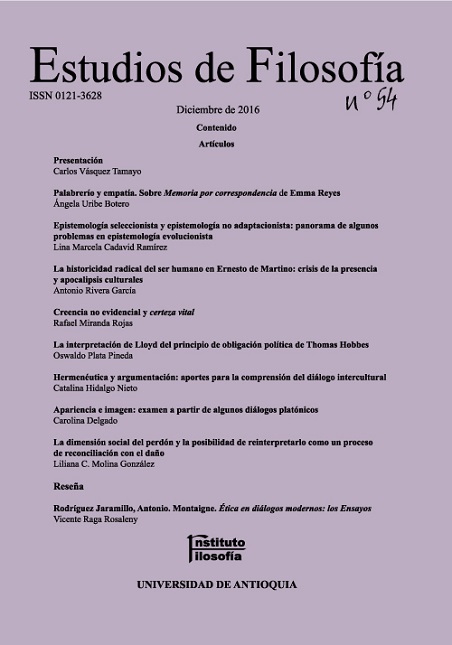Appearance and Image: a Review of some Platonic Dialogues
DOI:
https://doi.org/10.17533/udea.ef.n54.a08Keywords:
Image, appearance, Plato, mimesis, knowledgeAbstract
The aim of the present paper is to determine the Platonic treatment of image. For this purpose, the most relevant sections of four dialogues Republic, Sophist, Cratyilus and Phaedo are analyzed. Textual examination has contributed to detect a distinction that operates in Platonic treatment, namely the difference between 'appearance' and 'image'. While the former is an ontologically loss-making illusion, the latter assumes the role of sensible instantiation of the ideal-intelligible realities. Based on this second kind, Plato has conceived the possibility of an ideal mimesis and a comeback to the knowledge of forms.
Downloads
References
Ackrill, J. (1997) “Anamnesis in the Phaedo: Remarks on 73c-75”, en: Essays on Plato and Aristotle, Oxford: Clarendon Press.
Ambuel, D. (2007) Image and Paradigm in Plato’s Sophist, Parmenides Publishing.
Belfiore, E. (1984) “A theory of imitation in Plato’s Republic”, en: TAPA 114, pp. 121-146.
Bordt, M. (2006) Platons Theologie, Freiburg-München, Karl Alber.
Branwood, L. (1990) The chronology of Plato’s Dialogues, Cambridge: Cambridge University Press.
Collobert, C. (2011) “Poetry as Flawed Reproduction: Possesion and Mimesis in Plato”, en: Destreé, P. y Herrmans, F., eds. Plato and the Poets. Leiden-Boston, Brill: Mnemosyne Suppl. Vol. 328.
Cornford, F. (1991) La teoría platónica del conocimiento: Teeteto y El Sofista. Buenos Aires, Paidós, traducción N.L. Cordero y M.D. Ligatto, 2a reimpr.
Giuliano, F.M. (2005) Platone e la poesia. Teoria della composizione e prassi della ricezione, Sankt Augustin, Academia Verlag.
Görgemanns, H. (1994) Platon, Heidelberg, Universitäts Verlag C. Winter.
Marcos, G. (2006) “La crítica platónica a oradores, poetas y sofistas. Hitos en la conceptualización de la mimesis”, en: Estudios de Filosofía, Medellín, Universidad de Antioquía 34, pp. 9-27.
Nehamas, A. (1998) “Plato on imitation and poetry in Republic 10”, en: Smith, N., ed. Plato critical assessments. Volumen III. Plato’s Middle Period: Psychology and value theory. London and New York, Routledge, pp. 273-323.
Nightingale, A (2002) “Distantviews: realistic and fantastic Mimesis in Plato”, en: Annas, J. y Rowe, Ch., eds. New Perspectives on Plato, Modern and Ancient. Cambridge: Harvard University Press.
Notomi, N. (2011) “Image-making in Republic X and the Sophist”, en: Destreé, P. y Herrmans, F., eds. Plato and the Poets. Leiden-Boston, Brill: Mnemosyne Suppl. Vol. 328.
Palumbo, L. (2008) Mimesis – Rappresentazione, teatro e mondo nei dialoghi di Platone e nella Poetica di Aristotele. Napoli: Loffedro Editore.
Platon Werke. (2004) Phaidon, Band I 4, Göttingen, Vandenhoeck und Ruprecht, Übersetzung und Kommentar T. Ebert. Platons Phaidon, (1999) Darmstadt, WB, D. Frede.
Rosen, S. (1983) Plato Sophist. The Drama of Original and Image. Yale University Press.
Tate, J. (1932) “Imitation in Plato’s Republic”, en: Classical Quarterly 22, pp. 161-169.
Untersteiner, M. (1966) Repubblica. Libro X. Studio introduttivo, testo e commento. Napoli.
Published
How to Cite
Issue
Section
Categories
License
Copyright (c) 2016 Carolina Delgado

This work is licensed under a Creative Commons Attribution-NonCommercial-ShareAlike 4.0 International License.
Authors who publish with this journal agree to the following terms:
1. The Author retains copyright in the Work, where the term "Work" shall include all digital objects that may result in subsequent electronic publication or distribution.
2. Upon acceptance of the Work, the author shall grant to the Publisher the right of first publication of the Work.
3. The Author shall grant to the Publisher a nonexclusive perpetual right and license to publish, archive, and make accessible the Work in whole or in part in all forms of media now or hereafter known under a Creative Commons Attribution-NoCommercia-ShareAlike (CC BY-NC-SA 4.0), or its equivalent, which, for the avoidance of doubt, allows others to copy, distribute, and transmit the Work under the following conditions: (a) Attribution: Other users must attribute the Work in the manner specified by the author as indicated on the journal Web site;(b) Noncommercial: Other users (including Publisher) may not use this Work for commercial purposes;
4. The Author is able to enter into separate, additional contractual arrangements for the nonexclusive distribution of the journal's published version of the Work (e.g., post it to an institutional repository or publish it in a book), as long as there is provided in the document an acknowledgement of its initial publication in this journal;
5. Authors are permitted, and Estudios de Filosofía promotes, to post online the preprint manuscript of the Work in institutional repositories or on their Websites prior to and during the submission process, as it can lead to productive exchanges, as well as earlier and greater citation of published work (see The Effect of Open Access). Any such posting made before acceptance and publication of the Work is expected be updated upon publication to include a reference to the Estudios de Filosofía's assigned URL to the Article and its final published version in Estudios de Filosofía.















